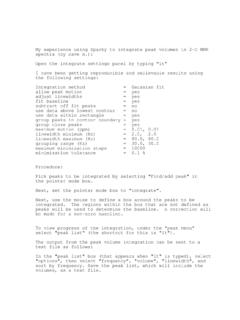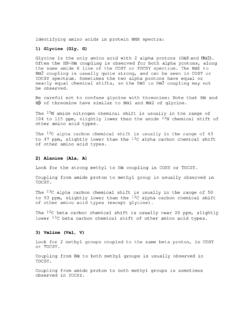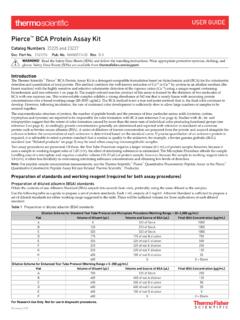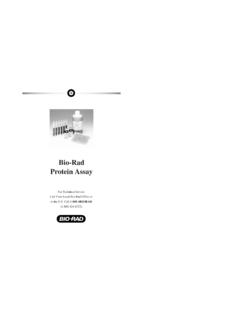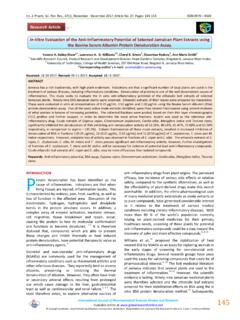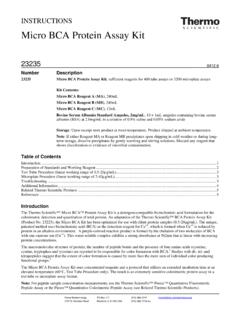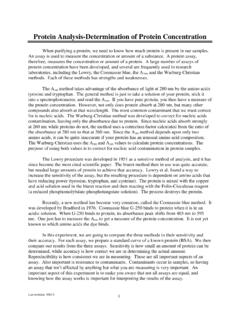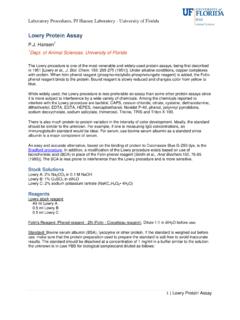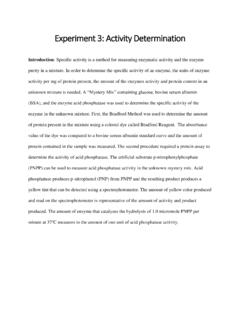Transcription of A Rapid and Sensitive Method for the Quantitation of ...
1 ANALYTICAL BIOCHEMISTRY 72, 248-254 (1976). A Rapid and Sensitive Method for the Quantitation of Microgram Quantities of Protein Utilizing the Principle of Protein-Dye Binding MARION M. BRADFORD. Reproduction Research Laboratories, Department of Biochemistry, University of Georgia, Athens, Georgia 30602. Received September 11, 1975; accepted January 29, 1976. A protein determination Method which involves the binding of Coomassie Brilliant Blue G-250 to protein is described. The binding of the dye to protein causes a shift in the absorption maximum of the dye from 465 to 595 nm, and it is the increase in absorption at 595 nm which is monitored.
2 This assay is very reproducible and Rapid with the dye binding process virtually complete in approximately 2 min with good color stability for 1 hr. There is little or no interference from cations such as sodium or potassium nor from carbohydrates such as sucrose. A small amount of color is developed in the presence of strongly alkaline buffering agents, but the assay may be run accurately by the use of proper buffer controls. The only components found to give excessive interfering color in the assay are relatively large amounts of detergents such as sodium dodecyl sulfate, Triton X-100, and commercial glassware detergents.
3 Interference by small amounts of detergent may be eliminated by the use of proper controls. Laboratory practice in protein purification often requires a Rapid and Sensitive Method for the Quantitation of protein. Methods presently available partially fulfill the requirement for this type of Quantitation . The standard Lowry procedure (1) is subject to interference by com- pounds such as potassium ion (2), magnesium ion (3), EDTA (4), Tris (3), thiol reagents (2), and carbohydrates (5). The relatively insensitive biuret reaction (6) is subject to interference by Tris (7), ammonia (8), and glycerol (9).
4 Even the modified procedure for eliminating problems with the Lowry and biuret assays (IO, 11) present problems since more complications and time are involved in the modified procedures. The dye binding techniques in the literature are for the most part insensitive assays involving the binding of Orange G to protein (12- 16). The excep- tion to this rule is the Amidoschwarz 10-B binding assay (17). This procedure, too, has its drawbacks since the precipitation of the protein by trichloroacetic acid followed by filtration on Millipore membranes is required. The protein assay herein described eliminates most of the problems involved in the procedures described above, and is easily utilized for 248.
5 Copyright 0 1976 by Academic Press. Inc. All rights of reproduction in any form reserved. PROTEIN assay BY DYE BINDING 249. processing large numbers of samples, as well as adaptable to automation. It is based on the observation that Coomassie Brilliant Blue G-250 exists in two different color forms, red and blue (18). The red form is con- verted to the blue form upon binding of the dye to protein (IS). The protein-dye complex has a high extinction coefficient thus leading to great sensitivity in measurement of the protein. The binding of the dye to pro- tein is a very Rapid process (approximately 2 min), and the protein-dye complex remains dispersed in solution for a relatively long time (approx- imately 1 hr), thus making the procedure very Rapid and yet not requiring critical timing for the assay .
6 MATERIALS AND METHODS. Reagents. Coomassie Brilliant Blue G-250 was obtained from Sigma, and used as supplied. 2-Mercaptoethanol was obtained from Sigma. Triton X- 100 was obtained from Schwartz/Mann. Sodium dodecyl sulfate was obtained from BDH Chemicals Ltd., Poole, England. Hemosol was obtained from Scientific Products. All other reagents were of analytical grade or the best grade available. Protein preparation. bovine serum albumin (2x crystallized), chymo- trypsinogen A, and cytochrome c (horse heart) were obtained from Schwartz/Mann. Hemoglobin and human serum albumin were obtained from Nutritional Biochemicals Corporation.
7 Protein solutions were pre- pared in M NaCl. Concentrations were determined for bovine serum albumin , human serum albumin , chymotrypsinogen A, and cytochrome c spectrophotometrically in a Bausch and Lomb Spectronic 200 uv spectrophotometer based on E~~,,+z= (19,20), (19,21), 20 (19,22). and (23,24) respectively. Hemoglobin solutions were prepared gravimetrically. Preparation ofprotein reagent. Coomassie Brilliant Blue G-250 (100 mg). was dissolved in 50 ml 95% ethanol. To this solution 100 ml 85% (w/v). phosphoric acid was added. The resulting solution was diluted to a final volume of 1 liter.
8 Final concentrations in the reagent were (w/v). Coomassie Brilliant Blue G-250, (w/v) ethanol, and (w/v). phosphoric acid. Protein assay (standard Method ). Protein solution containing 10 to 100 ,ug protein in a volume up to ml was pipetted into 12 x 100 mm test tubes. The volume in the test tube was adjusted to ml with appropriate buffer. Five milliliters of protein reagent was added to the test tube and the contents mixed either by inversion or vortexing. The absorbance at 595 nm was measured after 2 min and before 1 hr in 3 ml cuvettes against a reagent blank prepared from ml of the appropriate buffer and 5 ml of protein reagent.
9 The weight of protein was plotted against the corresponding absorbance resulting in a standard curve used to determine the protein in unknown samples. 250 MARION M. BRADFORD. Microprotein assay . Protein solution containing 1 to 10 pg protein in a volume up to ml was pipetted into 12 x 100 mm test tubes. The volume of the test tubes was adjusted to ml with the appropriate buffer. One milliliter of protein reagent was added to the test tube and the contents mixed as in the standard Method . Absorbance at 595 nm was measured as in the standard Method except in 1 ml cuvettes against a reagent blank prepared from ml of the appropriate buffer and 1 ml of protein reagent.
10 Standard curves were prepared and used as in the standard Method . RESULTS. Reproducibility, sensitivity, and linearity of the assay . Triplicate standard assays of bovine serum albumin as a standard result in a highly reproducible response pattern. Statistical analysis gives a standard devia- tion of of mean value for the assay . There is extreme sensitivity in the assay with 25 ,ug sample giving an absorbance change of OD. units. This corresponds to 5 pg protein/ml in the final assay volume. There is a slight nonlinearity in the response pattern. The source of the nonlinearity is in the reagent itself since there is an overlap in the spectrum of the two different color forms of the dye.
